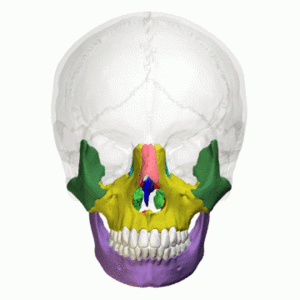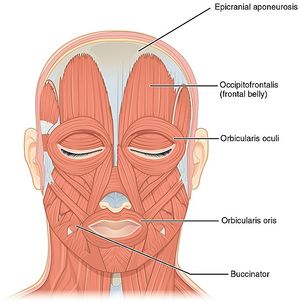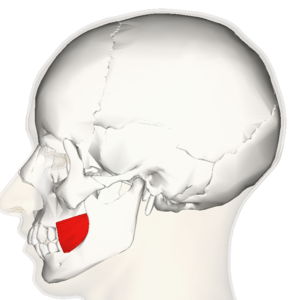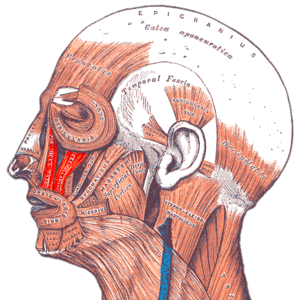Facial Muscles - Lower Group: Difference between revisions
mNo edit summary |
mNo edit summary |
||
| Line 35: | Line 35: | ||
The bulk of the mouth muscles are joined by a fibromuscular hub where their fibers insert. This structure is called the modiolus, it is founded at the angles of the mouth and it is primarily formed by the buccinator, orbicularis oris, risorius, depressor anguli oris and zygomaticus major muscles<ref name=":0" />. | The bulk of the mouth muscles are joined by a fibromuscular hub where their fibers insert. This structure is called the modiolus, it is founded at the angles of the mouth and it is primarily formed by the buccinator, orbicularis oris, risorius, depressor anguli oris and zygomaticus major muscles<ref name=":0" />. | ||
Each muscle is described individually below; | Each muscle is described individually below<ref name=":0" />; | ||
=== Orbicularis Oris === | === Orbicularis Oris === | ||
| Line 121: | Line 121: | ||
===== Assessment ===== | ===== Assessment ===== | ||
Place palpating finger just lateral to the nose. Ask the patient to either lift their upper lip to show the upper gum or flare their nostril to feel the contraction. Again this muscle can be difficult to distinguish from close by nasalis (medially) and levator labii superioris (laterally). | Place palpating finger just lateral to the nose. Ask the patient to either lift their upper lip to show the upper gum or flare their nostril to feel the contraction. Again this muscle can be difficult to distinguish from close by nasalis (medially) and levator labii superioris (laterally)<ref name=":1" />. | ||
=== Risorius === | === Risorius === | ||
===== Origin ===== | ===== Origin ===== | ||
Risorius is inconsistent for it's point of origin. It may arise from assorted points that may subsume the fascia of the parotid gland, fascia of the masseter and platysma muscles, and periodically from the zygomatic arch. | |||
Insertion | ===== Insertion ===== | ||
The fibers of the risorius gather medially and travel horizontally towards the angles of the mouth, where they mix with other facial muscles to form the modiolus. | |||
Nerve | ===== Nerve ===== | ||
Supplied by the buccal branch of facial nerve (CN VII). | |||
Artery | ===== Artery ===== | ||
Superior labial branch of the facial artery. | |||
Function | ===== Function ===== | ||
Described as the “smiling muscle” due to its main function of pulling the angles of the mouth laterally and superiorly to create a smile. | |||
Assessment | ===== Assessment ===== | ||
Place palpating finger closely to the corner of the mouth. Ask the patient to move the corners of the mouth laterally, as if to smile, to feel the muscle contract. Ensure that the palpation is not too far superior on the zygomaticus major<ref name=":1" />. | |||
== Clinical Relevance == | == Clinical Relevance == | ||
Revision as of 14:36, 19 October 2020
Original Editor - User Name
Top Contributors - Jacintha McGahan and Wendy Walker
Introduction[edit | edit source]
Located underneath the skin of the face and scalp are a group of 20 flat skeletal muscles. These muscles of facial expression, also named craniofacial muscles, are found in the subcutaneous tissue and emanate from bone or fascia, to attach onto the skin. They are a group of muscles that exclusively attach to skin and by contracting, the muscles pull on the skin and create movements of the face, such as smiling, grinning and frowning. Therefore, these muscles are commonly called muscles of facial expression, or mimetic muscles. All of the facial muscles are innervated by the facial nerve (CN VII) and vascularised by the facial artery.
The facial muscles are located around facial openings (mouth, eye, nose and ear) or extend over the skull and neck. Hence, they are divided into several groups;
- Muscles of the nose (nasal group)
- Muscles of the cranium and neck (epicranial group)
- Muscles of the external ear (auricular group)
- Muscles of the mouth or oral group (buccolabial group)
More specifically the oral group are accountable for movements of the mouth and lips. Such movements are necessary in singing and whistling and give emphasis to vocal communication[1][2].
Description[edit | edit source]
There is a total of eleven facial muscles that create movement at the mouth and their functions include:
- Lifting up and everting the upper lip: levator labii superioris, levator labii superioris alaeque nasi, risorius, levator anguli oris, zygomaticus major and zygomaticus minor muscles.
- Lowering and everting the lower lip: depressor labii inferioris, depressor anguli oris and mentalis muscles.
- Closing the lips: orbicularis oris muscle.
- Compacting the cheek: buccinator muscle.
The bulk of the mouth muscles are joined by a fibromuscular hub where their fibers insert. This structure is called the modiolus, it is founded at the angles of the mouth and it is primarily formed by the buccinator, orbicularis oris, risorius, depressor anguli oris and zygomaticus major muscles[1].
Each muscle is described individually below[1];
Orbicularis Oris[edit | edit source]
Origin[edit | edit source]
The fibres of the orbicularis oris surround the opening to the oral cavity. It comprises two parts; peripheral and marginal, with the border between them relating to the margin linking the lips and the surrounding skin. Both parts originate from the modiolus.
Insertion[edit | edit source]
- The peripheral part travels medially into the labial areas to insert on the dermis of the lips. In the midplane, a portion of the fibers intermingle with their respective fellow muscles to form the philtrum of the mouth.
- The marginal part travels from the modiolus on one side to the modiolus on the opposite side of the mouth. Some of the fibers curl upon themselves, forming the vermilion border, which is the boundary between the lips and the adjacent skin.
Nerve[edit | edit source]
Innervated by the buccal and mandibular branches of the facial nerve (CN VII).
Artery[edit | edit source]
Supplied from the superior and inferior labial branches of facial artery, with input from the mental and infraorbital branches of maxillary artery and the transverse facial branch of superficial temporal artery.
Function[edit | edit source]
A bilateral contraction of the whole muscle closes the mouth. An isolated contraction of particular parts of the muscle can produce various movements of the mouth, such as lip pouting, puckering, twisting and others. Through it's contractions the orbicularis oris assists speech and helps create a variety of facial expressions.
Clinical relevance[edit | edit source]
Assessment[edit | edit source]
Wearing a glove, place palpating fingers on the tissue of the lips. Ask the patient to pucker up the lips, and feel the contraction of the muscle. Once felt, palpate the entire muscle as the patient alternately contracts and relaxes[3].
Buccinator[edit | edit source]
Origin[edit | edit source]
The buccinator muscle shapes the muscular structure of the cheek, filling the space between the maxilla and mandible. It is comprised of three parts; superior, inferior and posterior. It originates from the external lateral surface of the Alveolar process of maxilla, buccinator ridge of mandible, pterygomandibular raphe.
Insertion[edit | edit source]
All three parts of the buccinator coincide towards the angle of the mouth and insert onto the modiolus and mixes with other muscles of the upper lip.
Nerve[edit | edit source]
Buccal branch of facial nerve (CN VII)
Artery[edit | edit source]
Main supply from the buccal branch of the maxillary artery, with input from branches of the facial artery.
Function[edit | edit source]
The buccinator muscle compresses the cheek against the molar teeth and forestalls the cheek from getting bit through mastication. Additionally, it aids to keeping the bolus of food centered in the oral cavity and limiting it from leaking into the oral vestibule. The buccinator has a role in playing wind instruments or whistling.
Clinical Relevance[edit | edit source]
Assessment[edit | edit source]
Place palpating finger lateral and marginally superior to the corner of the mouth. Ask the patient to take a deep breath, purse lips, and press the lips on their teeth as if forcing air out while playing a trumpet to feel the contraction of buccinator. The majority of this muscle is deep to the masseter and other muscles of facial expression, therefore, palpation and it's specific identification is difficult[3].
Levator labii superioris[edit | edit source]
Origin[edit | edit source]
A short triangular muscle that originates from zygomatic process of maxilla and maxillary process of zygomatic bone.
Insertion[edit | edit source]
It travels inferiorly and medially to attach onto the skin and intermingle with the other muscles of upper lip.
Nerve[edit | edit source]
Zygomatic and buccal branches of facial nerve (CN VII).
Artery [edit | edit source]
Blood is supplied by the facial artery and infraorbital branch of the maxillary artery.
Function[edit | edit source]
This muscle aids other buccolabial muscles to lift and invert the upper lip, showing the maxillary teeth and deepening the nasolabial lines. This movement is necessary in making some facial expressions, such as smiling, grinning and contempt.
Clinical Relevance[edit | edit source]
Assessment[edit | edit source]
Place palpating finger relatively half an inch or 1cm lateral to the center of the upper lip, at its superior margin. Ask the patient to lift the upper lip to show their upper gum and feel for the contraction. It can be challenging to identify the levator labii superioris from the close by levator labii superioris alaeque nasi (medially) and zygomaticus minor (laterally), as these also lift the upper lip[3].
Levator labii superioris alaeque nasi[edit | edit source]
Origin[edit | edit source]
A slim, strap-like muscle found on both sides of the nose. It originates from the upper portion of the frontal process of the maxilla and travels inferolaterally.
Insertion[edit | edit source]
It inserts to the fascia and muscle tissue of the upper lip and the fascia and cartilage of the nose.
Nerve[edit | edit source]
Zygomatic and buccal branches of facial nerve (CN VII).
Artery[edit | edit source]
Facial artery and the infraorbital branch of the maxillary artery.
Functon[edit | edit source]
It elevates the lip and flares the nostril. This muscle is considered a muscle of facial expression of the nose and the mouth.
Assessment[edit | edit source]
Place palpating finger just lateral to the nose. Ask the patient to either lift their upper lip to show the upper gum or flare their nostril to feel the contraction. Again this muscle can be difficult to distinguish from close by nasalis (medially) and levator labii superioris (laterally)[3].
Risorius[edit | edit source]
Origin[edit | edit source]
Risorius is inconsistent for it's point of origin. It may arise from assorted points that may subsume the fascia of the parotid gland, fascia of the masseter and platysma muscles, and periodically from the zygomatic arch.
Insertion[edit | edit source]
The fibers of the risorius gather medially and travel horizontally towards the angles of the mouth, where they mix with other facial muscles to form the modiolus.
Nerve[edit | edit source]
Supplied by the buccal branch of facial nerve (CN VII).
Artery[edit | edit source]
Superior labial branch of the facial artery.
Function[edit | edit source]
Described as the “smiling muscle” due to its main function of pulling the angles of the mouth laterally and superiorly to create a smile.
Assessment[edit | edit source]
Place palpating finger closely to the corner of the mouth. Ask the patient to move the corners of the mouth laterally, as if to smile, to feel the muscle contract. Ensure that the palpation is not too far superior on the zygomaticus major[3].
Clinical Relevance[edit | edit source]
Treatment[edit | edit source]
Resources[edit | edit source]
- ↑ 1.0 1.1 1.2 Gordana Sendic. Facial Muscles. Available from: https://www.kenhub.com/en/library/anatomy/the-facial-muscles (accessed 18 October 2020).
- ↑ Teach Me Anatomy. The Muscles of Facial Expression. Available from: https://teachmeanatomy.info/head/muscles/facial-expression/ (accessed 18 October 2020).
- ↑ 3.0 3.1 3.2 3.3 3.4 Muscolino JE. Chapter 12, Palpation of the Muscles of the Head. The Muscle & Bone Palpation Manual with Trigger Points, Referral Patterns, and Stretching 2nd Edition. United States: Mosby 2015. p221-59










